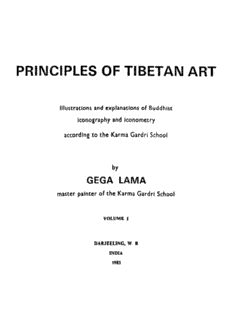
Principles of Tibetan art: Illustrations and explanations of Buddhist iconography and iconometry according to the Karma Gardri school PDF
Preview Principles of Tibetan art: Illustrations and explanations of Buddhist iconography and iconometry according to the Karma Gardri school
PRINCIPLES OF TIBETAN ART Illustrations and explanations of Buddhist iconography and iconometry according to the Karma Gardri School by GEGA LAMA master painter of the Karma Gardri School VOLUME I DARJEELING, W B INDIA 1983 RABSEL DAWA q^ 'q? ^ ^ ^ | , ^ ^ , q ^ FOREWORD This is s book on ths bodily proportions of sscrsd figures, ons of the brsnohes of ths manual srts, s division of ths trsdltlonsl tsohnlosl solsness which fora one of the five main fields of knowlsdgs. These Illustrations are the work of ths Llngtsang artist Gaga Lama and they are authoritative, having as their ultlaats sources the Sutras, Tantras and Practical Instructions. This first publication of these drawings Is an act of ssrvics to ths Buddhist Doctrine, and It la certainly trustworthy. Therefore I havs written this foreword. In order that others aay energetically study and thus carry on ths tradition of artistic practice In an undeteriorated state, and so that they may have confidence In this book. With prayers for ths Increase of excellent merit, j I)S,\ •>. f ^ Dhlngo Khyentse Rlnpoche TABLE OP CONTENTS preface Introduction Dedication Chapter One i The orlfflna of the Graphic arts of Buddhism Chapter Two i The ties of Artist and patron Chapter Three s The charaoteristics Determining the Quality of Images Chapter Four i The proportions of Reoeptaoles of Fon — I sages Chapter Fire t The proportions of Receptacles of Speech — calligraphy Chapter Six i The proportions of Receptacles of Mind — stupas Chapter Seven s The Ilesents of conposition — Garments, Hats» Gestures, implements Appendix i some controversial points in painting Various Drawings Colophon N&Û1 rVrr n =‘, « ,««AV »^«q-qq7 q«j*qW ujep^]«^' «|<^c,q^q,^;r^T*ip^r^*V q ^ ^ « J ^'qqq«^'qq"^q-«l<q-q'aj^r <»W| f^^W&^|-qW^,cA ^^‘ e ^ a ^ ^ i^ flS q ^ i ^q«v*Â-q^î^qq^|Sjj ^ ^ ^ • ^ • q ^ q é ~ « í q p « ^ ^ ‘^*j3jqq'q*^^q^qjj«l-»^'q,qr gq-q* $qg^q«r«^| ^ ' a « q ^ ^ * , ^ q | Jgr|^W5* p^-aj^ epa^-ep * q ^q^-qi7p - « ^ - q &q«'|pj«!T<Wj:,ir|5 «4 ’f)'^« «^' ^'ll-^qjq^ej-q-qí.^-^ipq-^^li'SI ^'^s*^q^- (Sp/aj^q* V^qq-^^q|-Sjq*3q '^q ^ajy q ^q p ^p'íp'W qp ^^•••|^'g=j^q|'qj'«^'q^*íM«si| ejqji^*qp|q|^'qq*q-^j'(q^'q«i|«i'q*^3j^ SVqgq-qp q ^-qfle^g^3^-q-¿^ ^•«ář<qq-^q*^-iJ^a«-q'^X| 5 qejfl|-^«|-S|-*i^|-^- «ajarsùSSp^-«^-*^ ^«r*va^ov ^ e ^ q ^ - q ^ RV^-q^rj j^^^-gJ^-q^g^03^qířqj^»A*ei* 6 PREFACE In explaining artistic traditions, there are physical, verbal, and mental art forms to be considered: this book is concerned with physical media, particularly the graphic arts. It is also concerned with traditional standards, rather than improvisation; and with the finest expression of those traditional forms, not the more ordinary applications. For these reasons, a word on the sources used seems in order* The principal text used was Music to Delight a Clear Intellect (bLo.gsal*dgyes*pa'i.rol.mo)f‘ which synthesises ideas found in the works of various masters — (the eighth Karvnapa hierarch) MlkyO Dor Je, the omniscient ButBn (Rlnchen Drup), Menla D&ndrup of Mentang, the regent (of the fifth Dalai Lama,) Sangyay Gyatso, and Trengkawa Lodrb Zangpo. These masters elaborated on earlier sources, sutras and tantras such as the Kalacakratantra (dPal*dus*kyi*'khor*lo'i*rgyud), the Mahasamvarodayatantraraja (dPal.sdom.par* •byuna.ba'l.rgyud), the (?) KSlayamatantra (aSin.rje.nag*po*i.rgyud), and the ¿¿rlputrapariprcchSsutra (Sa.ri*i.bus.zhus.pa'l.mdo). Additional sources for this book were the texts Beautiful Ornaments of the Arts (bZo.ria.mdses.pa*i. kha.rgyan) by Lobzang DamchO Gyatso, and Radiant Sun (Rab*asal*fTl*ma) by Mipam Choklay Namgyal. The oral instructions of my teachers, and my own experience, influenced my writing of this book as well. Althouqh the actual text may differ slightly from the old manuals, I see no contradiction but only harmony with the spirit of the tradition: there is no confusion or distortion in what Is presented here* Springwat^r, snowmelt, mountain streams — different, yet All come from the ocean and flow back to the ocean: Likewise, distinct traditions of knowledge deriving from Indian and Tibetan masters. Arise from the tantras and harmonize with the spirit of the tantras* A word on the system of dating u-ed in this book: there are numerous different systems put forth by scholars; that adopted here for datlna the buddhlst era (B.E.) from the year of the Buddha's parlnlrvSna follows the widely-accepted method of the Theravada school of £rl Lanka* This agrees with the system expounded by the great scholar of Kashmir (Kha*che*pan*chen ¿Skyadrl), and is the same view as that expressed by the former hierarch of the Kagyu school, the fourteenth Karmapa (Theg.mchog.rdo.rJe, 1798-1868). For example, in the calendar currently in use among Tibetans, the length of time from the year of the Teacher's passina until the end of the present and sixteenth actual cycle of sixty years would comprise a total of forty-two such cycles, hypothetically, with a surplus of ten years* Supposing the first of these cycles had begun with ------------------------------------------------------------------------------------------------------:------------y the fire hare year eleven years after the Teacher's passing (accountino for-the ten-year surplus)« the Iron bird year of the ninth cycle would correspond to the year of the passing of Jesus Christ; the fire ox year of the twentieth cycle, to the birth of Songtsen Gampo, the thirty-third king of the Tibetan royal dynasty; and the fire hare year of the twenty-seventh cycle« to the start of the first sixty-year cycle In the calendar actually In use nowadays. Noble character lies In the illumination of the depths of one's experience; Skilful transmission, In the continuing legacy of precise intelligence: With none of these qualities, I am an insignificant product of my times. Merely a follower In another’s footsteps. Gega Lama. 8
